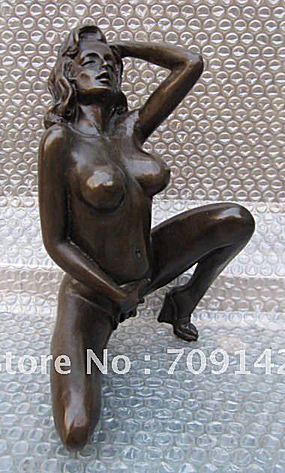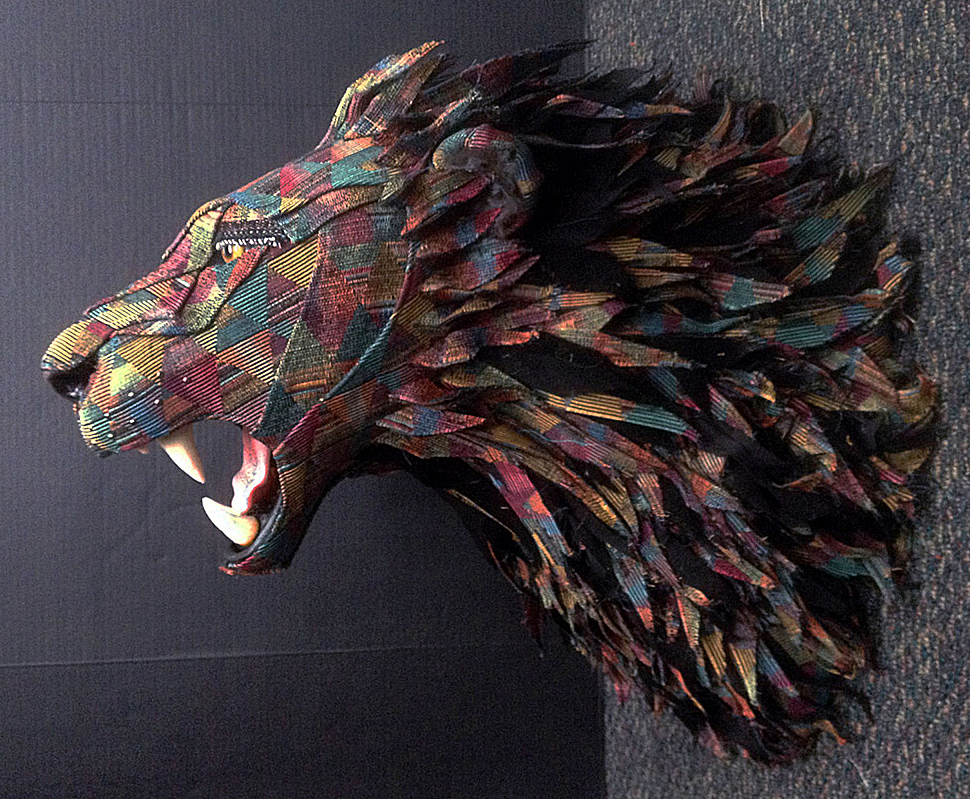Bored with garden gnomes?
Want something else to cheer up your front garden, and your neighbours?
Well then the AliExpress website has just the thing: erotic nude female statues like this one …

Why not start a new trend?
Bored with garden gnomes?
Want something else to cheer up your front garden, and your neighbours?
Well then the AliExpress website has just the thing: erotic nude female statues like this one …

OK, so last Thursday I posed the following problem from Alcuin of York:
A man has to take a wolf, a goat and a bunch of cabbages across a river. The only boat available can accommodate just two of them at a time. It is well known that if left alone together the goat would eat the cabbages, and the wolf would eat the goat; but the man has been ordered to transfer all of them to the other side dry and in good condition. How can he achieve this?
So this is how the man did it …
First take the goat across and leave the wolf and the cabbages behind. Then return (empty) and take the wolf across. Having put the wolf on the other side, take the goat back over (remember, you can’t leave it with the wolf!). Leaving the goat on the near side, take the cabbages across. Then you can return (empty, again) and having picked up the goat take it over once more. You should now have everyone on the far bank, safe and well, and you’ve had some healthy rowing.
How many of you worked that out? Good, well done.
Now the remaining challenge is to return the boat to it’s starting point. Bright ideas on how to do that — without getting wet or damaging your charges?
If you want to know more about Alcuin’s puzzles then Can You Solve Alcuin’s Puzzles? is a good starting point.

Here begin the problems to sharpen the young is the beginning of a wonderful text which it is believed was written by the Carolingian scholar Alcuin of York (c.735–804). The work presents over fifty mathematical puzzles many of which remain a challenge even for modern readers. Here is one of the best known, which you may well have come across before:
A man has to take a wolf, a goat and a bunch of cabbages across a river. The only boat available can accommodate just two of them at a time. It is well known that if left alone together the goat would eat the cabbages, and the wolf would eat the goat; but the man has been ordered to transfer all of them to the other side dry and in good condition. How can he achieve this?
As always there’s no prize other than the satisfaction of solving the puzzle — but do feel free to show off by putting your answer in the comments.
Answer on Sunday evening, as usual.
Oh, and no cheating!
Should you be of a mind, it is quite easy to buy examples of taxidermy: just go to a few local auctions and you’ll soon find all manner of creatures in glass cases.
But you can now go one better: Upholstered Faux Taxidermy Heads and Animals.

There was a brilliant piece in last Monday’s Guardian in which Stephen Moss asks what robots might learn from our literature. I give you a sample:
[A] new generation of robots combining artificial intelligence with great physical power may not … wipe us out after all. We can be friends, united in a common appreciation of Middlemarch. But a less sunny outlook is suggested by … the Shepton Mallet School of Advanced Hermeneutics [who] fed the entire world’s literature into a robot (called HOMER16) fitted with a high-powered computer; preliminary results are worrying.
Here are some extracts from the HOMER16’s initial readings.
Hamlet: Dithering prince with unhinged girlfriend demonstrates how dangerous it is not to act decisively. Interminable and convoluted plot obstructs the central message that your enemies should be dispatched quickly, brutally and mercilessly. Cannot compute the meaning of the strange “To be or not to be” speech. In what sense is that the question?
A Clockwork Orange: Frightening study that shows the extent to which a love of classical music can damage the human brain. The works of Beethoven seem to be especially dangerous. Fail to understand why this material is still played, even on radio stations that very few people listen to.
The New Testament: Ludicrous set of stories in which the sick are miraculously healed, fishes and loaves materialise from nowhere, and a young man comes back to life after being executed. The telling by four narrators is interestingly postmodern, but the plot is too ludicrous to hold the attention. Could not compute the long introduction called The Old Testament, which seemed very dull and repetitious.
À la Recherche du Temps Perdu: A book in need of an editor about a protagonist in need of a psychiatrist. Good on the dangerous consequences of eating cake.
[With thanks to Julian Miller.]
Clever New Yorker cartoon I spotted a week or so ago …

Another in our occasional series highlighting some of the strange things, and combinations of things, which pass through our local auction house. Here’s a selection from the latest sale. I’ve highlighted some of the more eccentric items.
A Parker pen with black lacquered body and gilt lid. A silk handkerchief printed with the Maginot line, a quantity of silk flags, some badges and a 1937 Coronation tin, an American propelling pencil commemorating The Loyal-Order-of-Moose incorporating a calendar made by Ritepoint, another pencil, four netsuke and a small religious book.
An mid 20th century Tudor gents wristwatch, five other wristwatches, a pair of silver cufflinks, a single 9 carat gold cufflink, old spectacles, a silver and mother of pearl fruit knife, old hat pins, two cork screws, a nut cracker, etc.
A decorative pipe bowl styled as a bearded Cavalier on a perspex stand.
Why would the Cavalier have been on a perspex stand? And then why model the perspex stand?
A lepidopterist’s collection of mounted butterflies in six cases, one pair with roundels containing approximately fifteen butterflies in each with neatly typed name labels, one display of butterflies of Malaya, etc.
Eighteen packs of old bus tickets, seven crowns, other coins including a Victorian florin and a Victorian half crown, a pretty marcasite necklace, a small quantity of decorative jewellery, three first day covers and some mint stamps.
A 1970s leather cased decanter set on wooden tray — sherry, whisky and gin with wooden lids, a large amethyst glass with clear twist glass stem, two glass paperweights, a musical beefeater, a pair of wooden candlesticks and a pair of brass similar, a quantity of horse brasses, a wooden pierced easel mirror encased by folding doors with foliate decoration etc.
An extensive suite of glassware across two shelves to include red and white whine [sic] glasses …
A taxidermy figure of a Kestrel.
A spelter figure of a lady carrying fruit signed by Morau and an oriental style table lamp.
Why had Morau signed the fruit? I need to know.
A set of six Babysham glasses, two Victorian wooden truncheons, a Japanese 19th century yellow ground brush pot, a small quantity of Wade whimsies, a folding vanity mirror, Woods & Co Verona pattern part fruit service, two ebony dressing table pots and covers, Japanese metal box and cover and a Guinness book of Records.
A quantity of stoneware tureens with covers, vases and lids, a small Doulton Lambeth vase, a Colclough part dinner service including dinner plates, side plates, cereal bowls, etc. a black glazed two handled vase, a small quantity of glassware and a model of a caravan structured as a light.
A quantity of pressed and other glassware including fruit bowls and comports, a part tea service, a vintage McDougal flower canister, a small quantity of cameras including Pacemaker, Konika and Kodak Brownie Twin 20, Aquascope 200, mother of pearl inlaid writing box, musical jewellery box, a circular ice bucket, a quantity of games including draughts, chess and dominoes, a pair of Oreset Rosa 39/8 dress making scissors, a green glass fishing float, gramophone needles, etc.
A pair of large Satsuma vases decorated with Geishas and a similar blue ground vase, a pair of flow blue tureens, a set of three graduated flying bird wall plaques, a Victoria china part tea service, a small amount of Royal Albert Old Country Roses tea ware including teapot, three glass decanters and stoppers, a Cottage ware butter dish and stand, a quantity of children’s annuals from the 1960s and 70s including Thunderbirds and a Laurel and Hardy Bumper book plus a Swinger two polaroid camera boxed.
A good collection of vintage metal wicker and wooden wares to include a large metal pan, a toaster, heat master teapots, sugar sifters, silver plated bowl, tray, two Victorian coal irons, wicker picnic basket, wooden trays, pretty Edwardian brass framed fire screen, a wooden chopping board converted to hanging rack with decorative spoons, etc.
A mahogany Canterbury with drawer and two wicker picnic baskets …
Why would a Canterbury be made with two wicker baskets?
A remarkable tribal carved coconut head wearing a vintage leather flying helmet with SLM goggles dated 1942, together with an early leather watch strap for wearing a fob watch on the wrist, and two possibly Sudanese native daggers with leather scabbards
A 19th century naval sword with cast brass guard and fragmentary scabbard, an Indian sabre and swordstick, two bugles, a Milbro 12 bore cleaning kit, and a hand bell
A charming musical poodle by Merrythought with wind up tail and matching hat and fleece outfit in navy blue.
Two shelves of assorted men’s boots and shoes, including Stone Creek, NPS and Reebok, also a box of modern bed linen, still in packets, two sewing baskets and contents and a book @The History of the Self-winding watch
A large box of flint rocks, some carved in the form of seated people, a quantity of enamel teapots, an old telephone, old stoneware storage jars, etc.
Six children’s violins, in cases and a cased Singer sewing machine.
A quantity of DVDs including Annie Get Your Gun and westerns, Australian rules football ball, stainless steel cooking pans, two picnic baskets and a leather briefcase